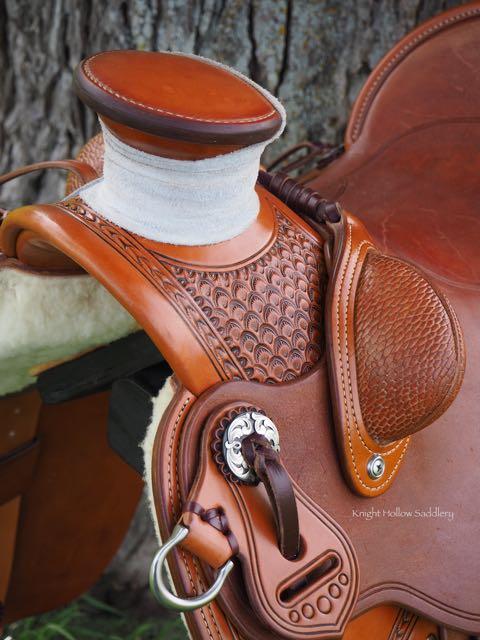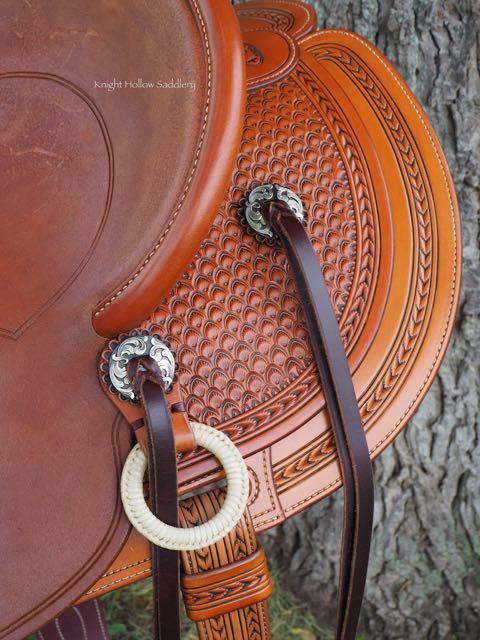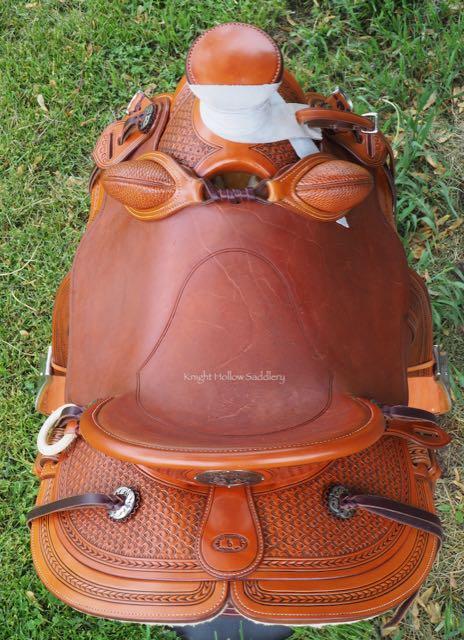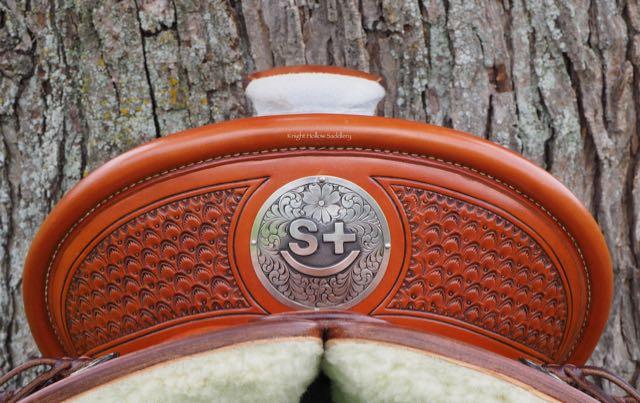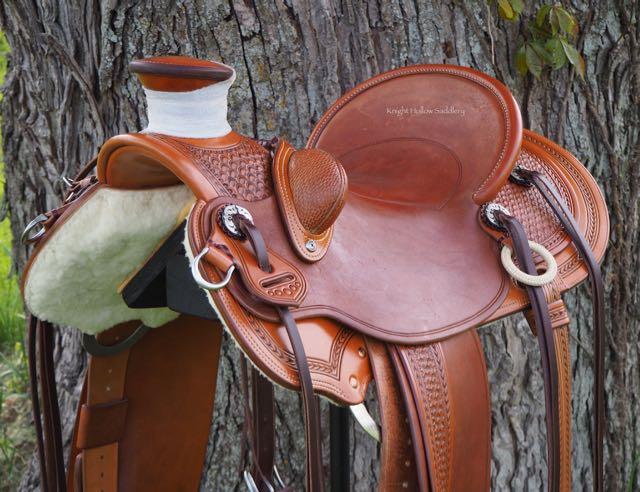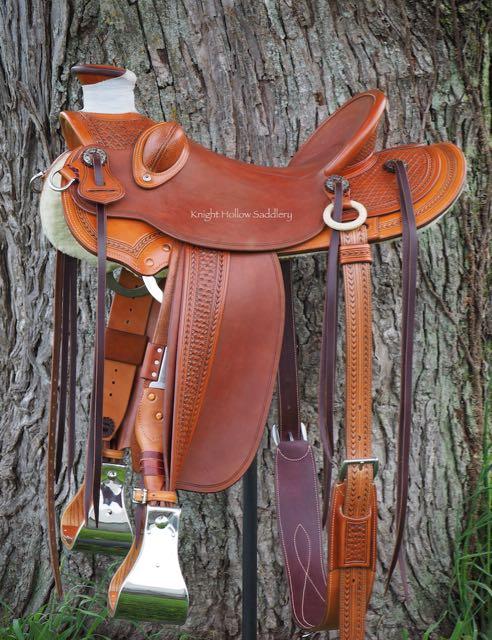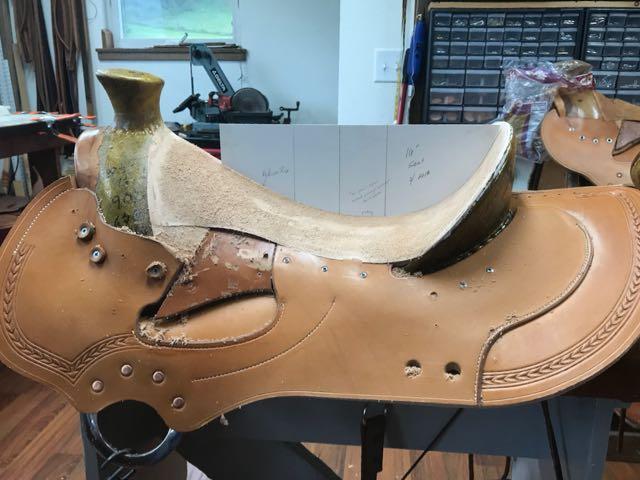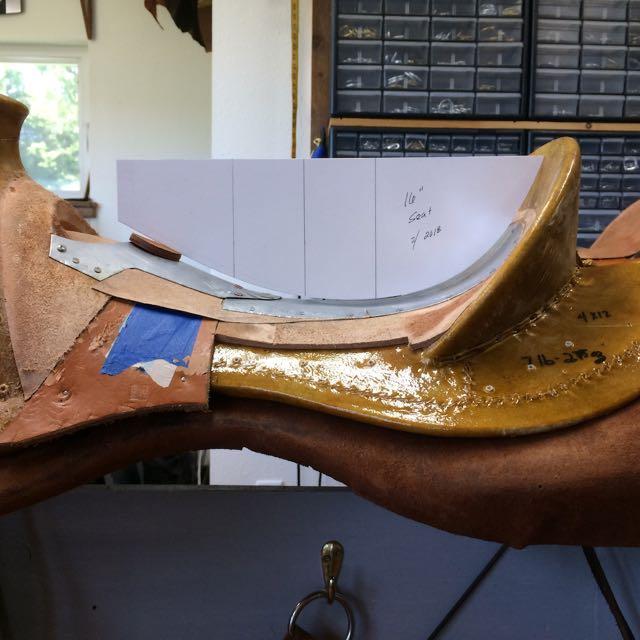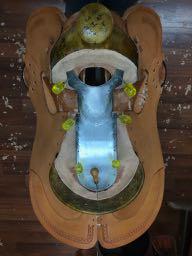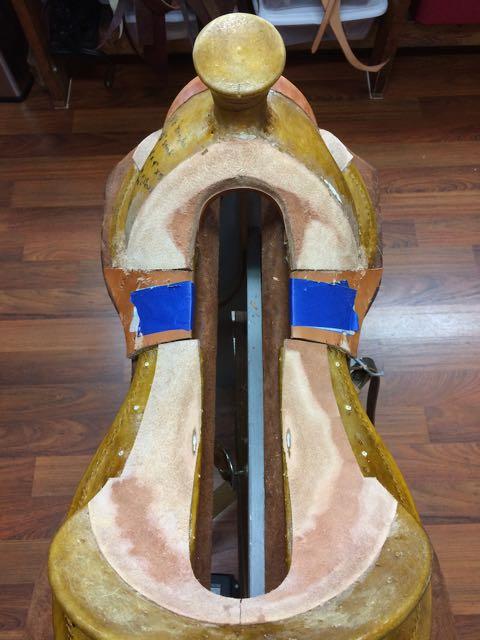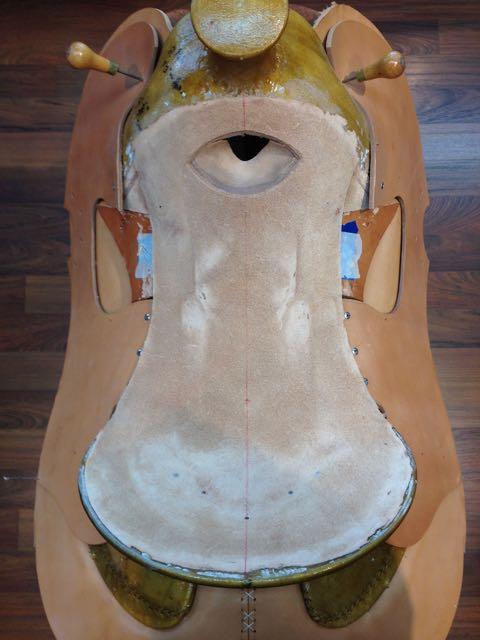
EdOdgers
Members-
Posts
91 -
Joined
-
Last visited
Content Type
Profiles
Forums
Events
Blogs
Gallery
Everything posted by EdOdgers
-
I have one I would sell. Message me if interested.
-
Reply to dfrensdorff: Top coat on stamped portions is Tankote. Finish process begins with 3 coats oil, then lacquer resist, followed by antique past (medium brown in this case), then Tankote.
-
Quick Change Stirrup Buckles
EdOdgers replied to gothcowboy's topic in Saddle Supplies, Tools & Trees
The "Veach" style buckles are available in SS from Batz, formerly Walsall. They are wholesalers. Some retailers carry them as well. The straps you incorporated in your leathers are a must for these buckles; without them folks get careless and the bottom post of the buckle will come out, leaving only the hook to carry the load and tearing the leathers. https://products.batzusa.com/viewitems/-categories-saddlery-and-tack-halter-square-equine/107ss-adjustable-stirrup-buckle- 7 replies
-
- stirrups
- stirrup buckles
-
(and 3 more)
Tagged with:
-
Many rigging plates are drilled for a #8 copper rivets. #8 rivets are a bit larger post diameter than #9 which won't be ideal but will also work if its all you can find (they are more commonly available). Copper rivets and burrs can be sourced at a good hardware store, leather supply retailers, farrier supply houses, etc. For riggings, it's important to only use solid copper rivets and burs with a post diameter appropriate for the hardware. For safety and durability, don't use "pop rivets," "tubular rivets," or any other type of fasteners. "
-
Saddle Skirt Attachment Method Question
EdOdgers replied to GrampaJoel's topic in Saddle Construction
Left over ends after cutting saddle strings; about 7 ounce. -
Buyer; Prices for a custom saddle are going to vary considerably. Most makers have a "base" price and a listing of extras. Evaluate each maker's "base" price carefully and note what is included. For some the base price is a ready-to-ride saddle with all of the amenities most folks would want, minus tooling and silver. For others, the base price is low-balled to get your attention and by the time you add the essential "extras," the price is comparable to the other maker. Quality of materials may vary a lot too, especially the tree. Current tree prices in custom saddles might range from $350 to $800 and up. The saddle can't be any better than the tree and the difference in quality is considerable. You really need to know who made the tree and how it's going to fit the horse. The style of the fork is usually all that most shoppers will know about the tree but that's the least important in the long run. Workmanship, artistry, attention to detail all will vary with each maker as well. Also, the reputation of the saddle maker has to be considered as it is an indicator of quality and will affect resale. Other things to consider are: the maker's wait-time; to what extent they welcome you in the design process; are they able to help you fit your horse(s); do you like the style or look of their saddles; do you like the seat they build into the saddle; are they able to answer all of your questions and help you choose the features you will value? You've got to feel good about the process as well as the final product. Of course, you need to evaluate what your needs are too. Do you know what you want and appreciate top quality or are you a beginning saddle buyer that is likely to be learning what you need and want? IMO the best reason to commission a custom built saddle is because you have specific desires and needs for your saddle and you want to be part of designing it. If this isn't the case, with some diligent searching you can find a good quality used saddle that is deeply discounted from the "custom" price. In my estimation, you can find a good to great saddle maker with legitimate base prices in the 3,500 to 5,000 plus range. If you want a high quality saddle, I'd be leery about makers priced much lower. Given the cost of quality materials (my material input cost at wholesale prices is now about $2,100 with premium trees), I would have to wonder how and why they are able to do it. You can't make a silk purse with a sows ear.
-
Pre-made latigo holder with breast collar tab
EdOdgers replied to DirtyDusty's topic in Saddle Supplies, Tools & Trees
The pictured D can only accommodate a 3/4" tug or connecting strap. Therefor, the D attachment is as strong or stronger than it needs to be since the 3/4" breast collar strap will surely tear through at the buckle tongue, way before the D attachment fails. 14 oz. skirting leather, 1" wide, wraps the D and is screwed stoutly to the tree (three screws). Most parts on a saddle don't need to be infinitely strong, just stronger than the next weakest component in the line of pull. The design needs to match the saddle and the intended use. A tripping style breast collar should be chosen for extra heavy use. Two 1 1/4" wide harness leather, or 1" double and stitched straps on each side, one in the rigging and one in the cinch ring. No breast collar D's at all. It you felt you needed this type of breast collar it would be wise to match it to a saddle and tree that is equally stout. It's going to be a stout and very heavy rig for sure. I agree there are folks who may need and want that type of outfit but I don't get asked to build them nowadays. -
Pre-made latigo holder with breast collar tab
EdOdgers replied to DirtyDusty's topic in Saddle Supplies, Tools & Trees
Never seen any but they are a pretty simple thing to make. Making them would be a good exercise in pattern-making and result in a piece that is uniquely yours. Give it a shot. Alternately, you might be able to find a saddle maker that has had a clicker made for this. If they are willing, you could possibly have them punch some out for you. -
It's true that you'll never build a saddle better than the tree, so don't settle for poor quality. Also, once you build on it you won't be able to control where it goes and what it does for it's lifespan, yet your name will be forever attached to it. Given the expanding list of problems with this tree, like Ken, I now suggest you not to build on it. The asymmetry you mention is a fatal flaw and is not likely to be the only one. I suggest you return it. Based on the asymmetry alone, they should honor your request for a refund. Where did you get this tree (I have my suspensions) and from whom might you buy your next? We might be able to offer critiques or suggestions. You don't need to buy at the very top of the price range to get a functional, durable, symmetrical tree.
-
No, you weren't over thinking the stirrup leather issue. That's a critical place in a tree. Based on your description of the bubble in the rawhide and the puckered rawhide around the nails, looks to me like the tree maker didn't pay enough attention to the dry-down of the rawhide. Better quality trees are tended to during the drying process and each day the seams are pounded or rubbed down, along with wrapping the horn neck and any areas that aren't flat and smooth. To effectively reinforce the tree, rawhide needs to be smooth and tight to the wood. Rawhide trees should have a protective coat of varnish or other coating to prevent absorption of moisture and the damp-dry cycling that will lead to cracking. So, once the area you moistened and flattened has dried, coat it with a couple of layers of spar varnish or urethane. It might be a good idea to paint the entire tree with spar varnish as it doesn't appear to have a thick protective layer. On second thought, to ensure that another coat will adhere well, consider asking the tree maker what they used and coat it with the same product.
-
No need to fill the depressions. They will be buried as work progresses and will have not impact on the final product. What's the bandage wrapped on the bar?
-
-
OldRedMule, Responding to your question about bar risers under the strainer: Yes I put in risers under my strainer but not to increase the clearance over the spine. I do so to create clearance for the stirrup leathers and initiate the shape of the groundseat. Clearance over the spine, even on a mule, should be adequate with the combined thicknesses of the bars, the skirts and the sheepskin. If more is desired, a saddle pad with the entire spine cut out would be a better choice as a standard pad will want to bridge across the bars regardless of how deep you made the "tunnel." The downside of your approach is that you are elevating the seat for the rider. I want to keep the rider as close to the horse, or mule, as is practical. You can see in the photo below that I have carved the risers down to the tree in the "pocket" region of the seat (low point). The strainer will be in contact with the tree at the pocket and there will be very little leather left on the final groundseat layer in that location. The reference mark on the risers is 3" behind the back of the stirrup leathers. There are two places I want the seat to be as close as the tree will allow: the pocket and over the stirrup leathers at the bottom of the bars.
-
Photo shows screw placement to secure skirts to tree and ensure the "gullet" under the cantle provides ample clearance for spine. Before blocking in skirts, I place a piece of leather in the cantle gullet to simulate the combined thickness of the cantle-back and jockeys. Thus, during final assembly the skirts will be bedded to the correct, finished depth in the cantle gullet. I also put a small brad nail dead center through the spacer leather in the gullet and leave about 1/2" protruding. I use a nippers to cut off the head of the protruding nail and then force the seam between the skirts over the nail to assure my skirts are centered on the back of the tree. Dusty or Ben and Caleb will build you a good tree and understand how to interpret your Lane card results.
-
OldRedMule, Here's a response I made to an older post that may address your question on lacing skirts. There were some photos in the post as well. You could look up the whole discussion under "Building my first mule saddle." Here is the exerted response: Posted April 9, 2020 Its imperative to maintain clearance over the spine for both horses and mules, no exceptions. Design and construction principles won't vary between a mule and horse saddle. The spinal process (ridge of bone extending vertically) of each vertebrae is not covered by muscle and is very near the surface along the top-line, making it vulnerable to injury. That's why our saddle trees have a gullet under the fork and the bars are spaced about 3" apart. That clearance should continue under the cantle where there is another "gullet" or arched area to create clearance. Skirts should be "blocked" or "bedded" to the tree bars such that the skirts are molded away and don't apply pressure to the horses back. When blocking skirts, you'll need to mold the skirts up into the gullet under the cantle and continue that arch to rearward to the bar tips. In addition to proper blocking, the angle of the cut on the skirts where they come together behind the cantle needs to cause the joined skirts to flare upward, continuing the angle of the bar. When cinched down, you should be able to slip your hand under the skirts behind the cantle fairly easily until the bars are encountered. Beyond the bars, the skirts shouldn't apply pressure to the back, period. Thus the saying "ride the tree, not the skirts" is important for saddle makers to adhere to. If the saddle maker hasn't molded the skirts to maintain that arched tunnel under the cantle and behind it, or if the skirts aren't cut properly to angle up up away from the horse behind the cantle, there will be pressure and friction that may sore a horse or mule in the loin area. This is a fairly common but easily avoided problem. Lacing the skirts together can add to the problem by not allowing the skirts to flex away from the horse. Also, the added thickness of the lace can cause a pressure point. All this is avoidable with proper blocking and the proper angle on the skirts where they join. The problem is caused by improper construction, not just the lacing. A properly built saddle can have the skirts laced together and maintain good clearance. That said, lacing the skirts together is not essential and could be eliminated if you made other provisions to secure the skirts to the tree. My practice is to install two screws through the skirt edges and up into the gullet of the cantle. This helps secure the skirts and ensures that the arch I molded into the skirts is maintained. I normally lace the skirts together behind the cantle but haven't always. I usually don't lace past the bar tips and not so far back as to be visible from under the jockeys. Leaving the last few inches of the skirts unlaced allows the skirts to flex away from the horse if the saddle happened to be used on a horse with unusually prominent muscles on their croup. Occasionally I have laced all the way to the back of the skirts as a design feature. This shouldn't cause any pressure or problem if you have designed ample upward flare to the back of the skirts. If you don't lace the skirts together, I suggest the previously mentioned screws into the gullet of the cantle and stitching pockets onto the topside of the skirts to slip the bar tips into.
-
Given the extent of wear shown in the photo, a 'wear leather' over the rigging may be the only way to prolong the life of this saddle for very long. As Ron said, the area needs to be restitched but there's no way to cut (recess in a groove) those stitches in deeply enough to prevent them from being worn away very quickly. The wear leather may be the only practical way to protect the stitching and thus the rigging integrity. The sketch below shows how the wear leather might be done. It need not be too thick as it is easily replaceable. This issue provides a good lesson in saddle construction. In the area shown, the stitch groove should have been much, much deeper. Most production saddles are notorious for this problem and thus cannot endure hard use. For durability, I typically take three passes with my stitch groover in these areas of high wear. Of course, the leather needs to be thicker in the rig to accommodate that deeper groove. A saddle's design and quality of construction help determine it's life span.
-
I've used the Watt 5053 plain rig plates (they call them "Front Flat Plate" #04152) and the rear rig plates for flat-plate rigged saddles; Good quality and very symmetrical. However, I almost always use 550 plates for inskirt rigs and I don't feel the Watt 550 plates (they simply call them "Inskirt Rigging Ring" #04132) allow the design flexibility I want. Unfortunately they have a flat, horizontal recess cast into the plate where they assume the skirt leather should end. Problem is I don't want a flat spot on my skirt there. IMO it looks like a wart on your nose to have that flat spot on a rounded skirt. So I find them unusable for anything but a square skirted, inskirt rigged saddle, which I have yet to do. The 550 plates on the saddle pictured are generic cast SS that are commonly available from Panhandle or Montana Leather, and others. Before they quit making them I used Harwood 550 plates and thought they were the best. I've also used Bork 550 plates in bronze or cast in nickel bronze to come closer to matching the other SS hardware. The reason I use 550 plates for inskirts is that the bottom of the plate can extend about 2 1/4" below the skirt/rig leather. Plates such as the 5053 or 777(powder river), which I might use in a flat-plate, the rig/skirt leather has to extend down to the bottom of the plate. This would create an excessively deep appearing skirt when the rig is moderately low or a "dropped 7/8" rig position like this one (6 1/2" from bar bottom to rig bottom and 1 5/8" behind full). With anything but the 550, I just can't get the balance and line that I want with the skirts. Bork and Watt make another rig plate that some folks use for inskirts that has a similar drop. The Watt version is called "Dual Purpose Plates." It has the space to add a leather plug for stitching. I used some of these when Herb Bork first developed the style but quit using them after seeing over time and hard use the plates gap away from the leather just enough to be unsightly. By the way, the flank buckles on this saddle are Watt's plain roller flank buckles.
-
Goldshot Ron; The breast collar D's are actually Watt hardware. They are some of the few 'plain' items without the faux engraving. I'm in agreement with you, I prefer the plain hardware unless it's actually engraved. The silver set on this saddle is by Ryon Edmonds. rdl123; Thanks Ron, much appreciated.
-
Thread Type, Machine and Hand, for Saddles
EdOdgers replied to FlyinBP's topic in Saddle Construction
I use 277, top and bottom, in my machine for almost all saddle stitching. Nylon or poly, but I have a small preference to the poly. For hand stitching I used to use waxed linen but have gone to machine thread waxed with bees wax. My machine stitching is at 6 spi; on working saddles I use 5 spi for the horn and cantle and up the thread size to 346. I sometimes use braided poly (346) for cantles and horns. It's nicer to work with but not as pretty as the machine thread with the visible twist. -
Ron: Thanks. The rough-out parts (seat and fenders) are selected from clean smooth hides with some character (veins). I also sand them after parts are rough cut using an orbital sander hooked up to a vacuum. Battlemunky: The buck rolls are made from beaver tail. It's an incredibly durable leather with a lot of character and interest. Pricey but my favorite. Always gets comments.
-
A 550 will work just fine in a flat-plate rigging. I have put 550s in flat-plates but usually prefer the 5053 or 777 due to the smaller overall area (rigid area created by the hardware) and because I like the separate slot for attaching the latigo (doesn't wear out latigos as quickly). You can also put a 5053 or 777 in an in-skirt but I never do because they require that the rig/skirt leather extends to the depth of the bottom of the rig plate. This becomes an aesthetic challenge since the skirts/rig will need to be very deep for a "dropped 7/8" rig position that I want to achieve (1 5/8" behind full and 6 1/2" below bar bottom). With a 550 the bottom of the plate extends about 2 1/4" below the skirt/rig leather. The reason this isn't a concern with a flat-plate is because the skirt's depth and shape is independent of the rig.
-
Referring to your May 18 post, the reason you are down to the grain on the top piece of leather and still have too much rise is because the first layer wasn't carved down enough. There are two ways to go about creating groundseats, one is to lay on the layers of leather and then start carving. IMO, a better way is to fit and carve down each and every layer, starting with the risers and tin, with the goal that each layer will be as close to final as possible. This way you will not only have a proper shape but it will also be closer to the tree and horse. Below are photos (not in sequence) illustrating how I depend on a vision of the final seat shape to define each step. By the time the strainer is in, I'm almost there and in most cases I only need to apply one layer of leather over the strainer. Note that I'm using my templates early in the process, not just during final carving. Not shown are the other templates that are perpendicular to the one shown. Also note in the first of the sequence (last photo), the risers that will support the strainer have been carved down to the tree at the low spot or "pocket" of the seat. With this mindset and process I feel I keep my groundseat as close to the horse as the tree allows. Answer to the question about the drop of the rig plate: Most of mine are 6 1/2" from bottom of front bar pad to bottom of rig plate. (Bars vary in width, mine are quite wide at about 6") The skirts are about 11 1/2" at the rear rig.
-
The ground seat at back of the stirrup leathers should be paper thin at the bar edge. That's the area that needs to be as NARROW as the tree and stirrup leathers allow. I like to see the metal from the strainer peeking though at the back of the stirrup leathers. That way I know I've removed enough. Your "pocket" or low point looks to be in the right place (about 3 1/2" behind stirrup leathers) but should be more concave as it rises to the fork; it's too straight now and should be more of an elliptical shape.
-
A bare tree on a horse or mule will give you a good indication of the suitability of the the bars angles, width and rocker but it will not provide conclusive information on the clearance of the gullet, groundseat and cantle gullet. To check for clearance, put a firm thick pad under the tree. Use pad(s) thicker than you intend to use in order to replicate the skirts, sheepskin and pad you will be using with the finished saddle. It's typical when placing a bare tree (no pad) on an animal for the gullet to be at or near the withers, yet the finished saddle will have ample clearance. The same and more will be true for the groundseat, since the sheepskin and skirts will not extend over the spine area. I suspect that when you make the same test with padding, the clearance will be adequate. The 5-Star pads you are referring to can be helpful for a mule with a prominent ridge along it's back. Essentially, these pads have the same affect and will add to the clearance created by the sheepskin and skirts. The cut-out isn't so much to compensate for the lack of clearance of the saddle (the saddle should have enough clearance regardless) but to prevent the pressure and friction along the ridge of the spine from the pad being pulled down tight across the top of the back. That "ridge" type of back just can't get any relief from the pad or blanket, even if the saddle isn't bearing down on it. This is the same concept as the contour shape of many felt pads which corrects for the tendency of a flat pad pulling tightly across a horses withers despite the saddle having adequate wither clearance. It's also why good horseman will tuck up the pad/blankets into the gullet before cinching up.


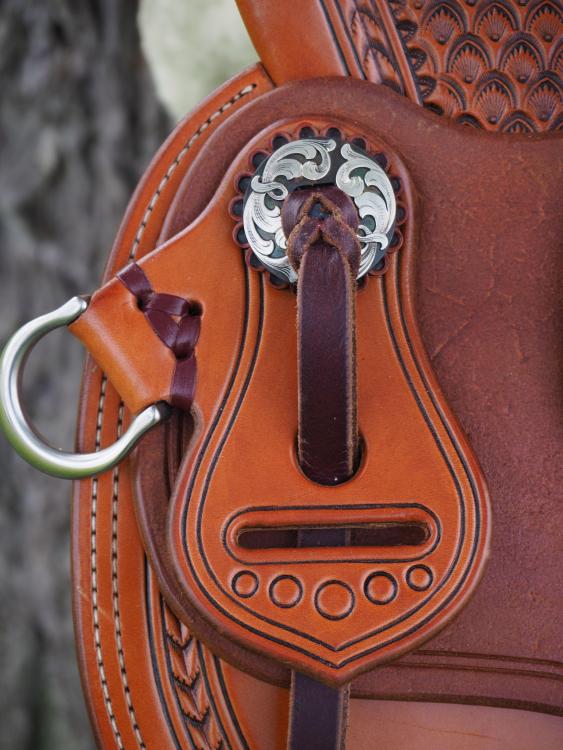
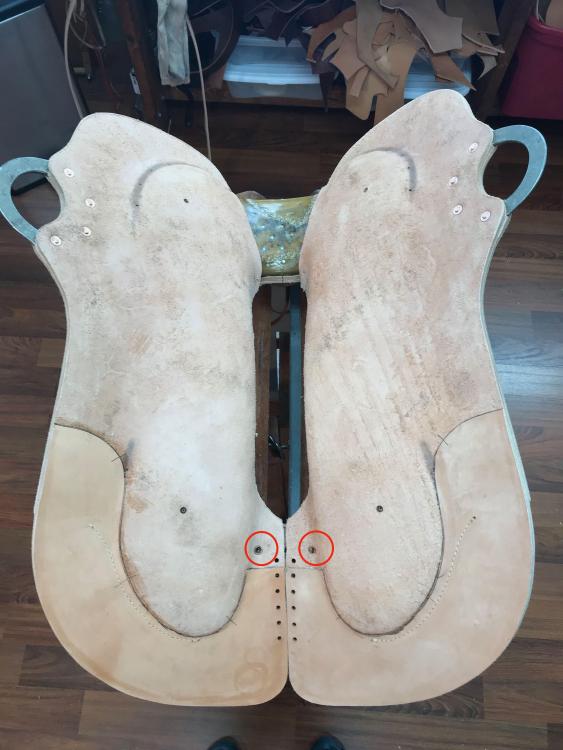
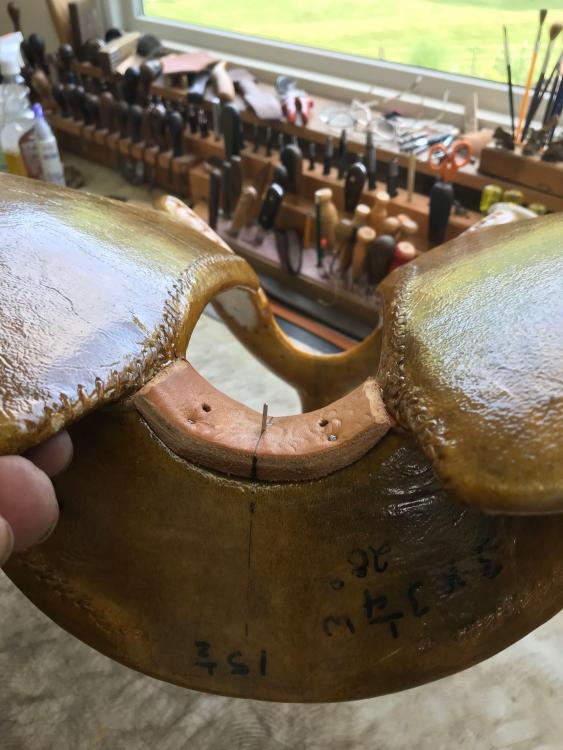
.thumb.jpg.1a226b86ecae5f6b3645431958a802de.jpg)

